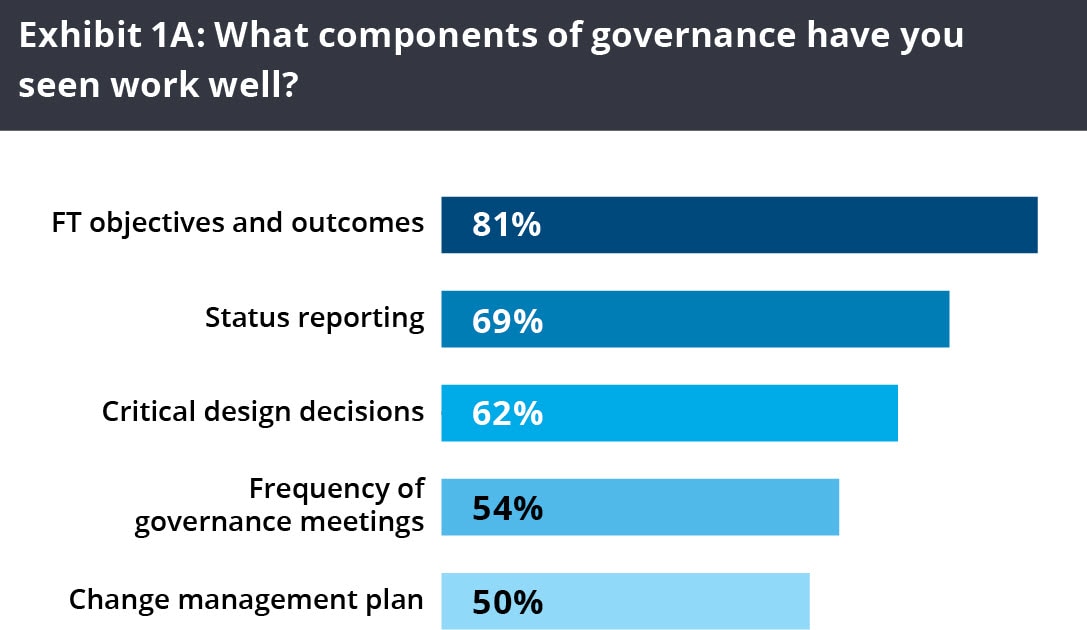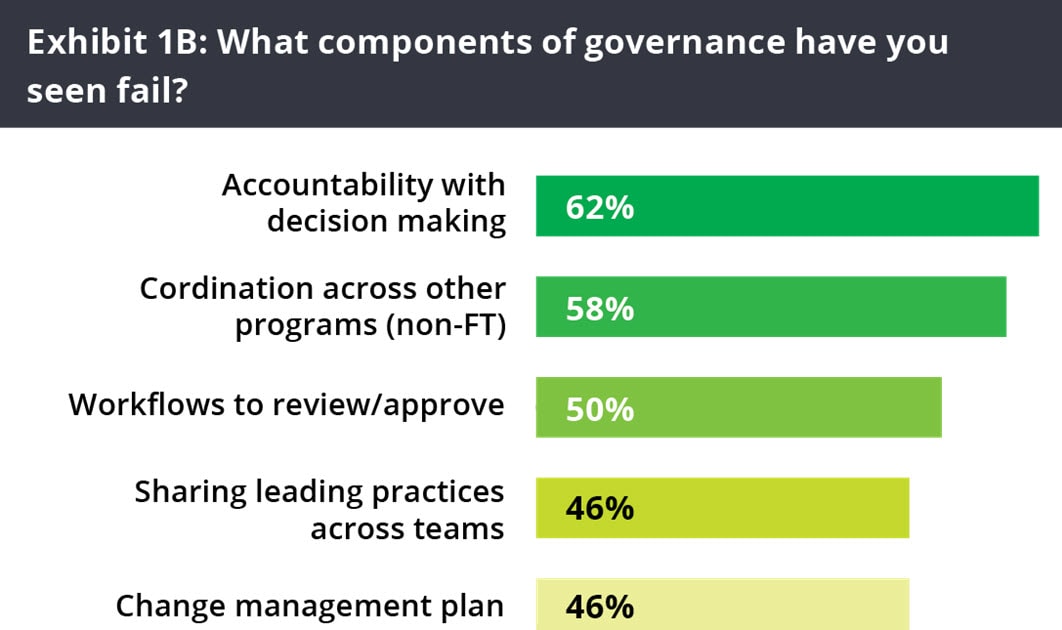Purpose-led governance – elevate your game has been saved

Analysis
Purpose-led governance – elevate your game
Governance for finance technology modernization
How can organizations accelerate their digital transformation journeys? It starts with purpose. Discover how purpose-led governance can help set your organization on the pathway to sustained success.
84% of digital transformation projects don’t reach their stated goals.1 It’s a jaw-dropping statistic that can make your heart sink, especially if you are about to embark or are already in your transformation journey. There is a myriad of causes that hold programs back from achieving their objectives. We will explore how purpose-led governance in digital transformation can elevate your game and keep you “locked-in” on your north star.
According to the Project Management Institute, “governance is the framework, functions and processes that guide activities in project, program and portfolio management.”2 At Deloitte, we also believe that the main objective of governance is to produce sustainable value. Its mission is to deliver meaningful outcomes for Finance, IT, and their business partners. Putting in a new finance platform can be expensive, complicated, and have far reaching impacts to stakeholders companywide.
Purpose-driven governance can help accelerate our clients’ finance modernization journeys. “Accelerates” as in helping clients transform better, faster, stronger—while preserving committed benefits. It’s the fuel that will likely boost and sustain a successful finance modernization program. This year, we surveyed3 Deloitte leaders who helped clients successfully transform the Finance function using new finance systems and improved processes. Per survey responses, when it pertained to overseeing a finance technology enabled transformation, there were key areas for improvement. We will focus on three—accountability with decision making, administrative workflows, and the plan for managing change.
What are organizations struggling with the most

 |
 |
More than half of the survey participants indicate accountability challenges with decision making. There are various triggers to this problem. They typically range from failing to define clear owners, blurring what decisions are within that individual’s mandate, and not empowering their delivery leads. For example, “Am I accountable for deciding what reporting dimensions need to be setup in the General Ledger? Or am I just to provide an opinion?” We’ve seen the effectiveness, speed, and quality of decisions impeded as different priorities and stakeholders’ interests compete with one another.
Close to half of the survey participants find themselves immersed in a sea of documentation and suffer from “death-by-committee”. It suggests rigid conformity to rules that can threaten the quality and experience of the implementation program. For example, each “ask” is treated the same whether immaterial or material. It’s subject to the same protocol for review and approval. Pages and pages of status reports are filled out for different governance bodies which takes tremendous amount of patience, and energy to decipher.
The lack of a clear communication and change management plan is another obstacle that programs grapple with. Almost half the survey participants ranked this issue in their top 5 areas that need improvement. For some programs, managing change is an afterthought. Their primary focus is three-fold: ensure the solution adheres to requirements, stays within budget, and is delivered on time. At Deloitte, we strongly believe that a finance system is only as good as how well it is received by the users. If people revert to old norms and attempt to work around the platform, that can be fatal to the success of the program and the sustained adoption of the newly implemented platform. It is imperative that the “What does this mean for me?” question is answered at the collective and individual level. Without a deliberate, intentional plan to manage change, there can be global or local bands of resistance that could suppress the effectiveness of the solution, whether intentional or not. In response, communication needs to be early, often, consistent, and transparent.

Purpose-led governance
Leaders should focus on developing a purpose-led governance framework that clearly defines the desired outcomes and the journey to get there. We want to spotlight several high-performing behaviors in program governance that make finance transformation successful.
Build the right team to manage change
As Phil Jackson said, “The strength of the team is each individual member. The strength of each member is the team.” The success of your governance team is a function of the extent to which it manages risk, challenges status quo, and embraces transformation.
The Steering Committee should promote thinking beyond existing frameworks and encourage out-of-the-box ideas. It should encourage constructive dialogue with businesses, challenge non-configurable software customizations, and deviate from the standardized solution only if proven necessary. Thus, the Committee should include the CFO, CIO, and their delegates with high visibility and expertise in technology and finance modernization programs. According to the survey, nearly 67% of the programs were actively championed by the CFO. And close to 40% were co-championed by both CFO and CIO—a statistic we would prefer being higher.3
Similarly, the Design Authority Committees should include a diverse set of individuals who can enable your organization’s ability to drive sustained change. Diverse representation from impacted businesses, different product lines, corporate departments (e.g., HR, Audit, Legal, Risk), super user groups, software vendors, and system implementors is key. Multi-functional and inter-departmental perspectives are typically backed by rich on-the-ground experience and thus, can build a strong case for challenging the status quo. It is imperative that these committees embody professionals who can envision and re-imagine new ways of working, adopting greater standardization than customization. This is relevant for cloud finance technologies, which require a paradigm shift to “Why can’t the out-of-the-box capabilities meet your needs?” and often needs hard decisions by business users.
At Deloitte, we believe a periodic evaluation of committee members and their role as advisers is crucial to enabling a fit-for-purpose governance model.
Your gauge: Drive accountability via key performance indicators
As transformation programs are usually complex with involvement from diverse teams, lines of accountability may often be obscured. In addition to the traditional RACI construct (identifying who is responsible, accountable, contributing, or informed), we believe that delegating ownership of outcome-oriented KPIs to project sponsors and workstream leads can provide clarity of expectations, decision-making authority, and set accountability. Organizations often establish KPIs which are inclined towards addressing qualitative questions which may leave room for ambiguity. Hence, it is critical that the program vision is broken down into qualitative and more importantly, quantifiable measures. For example, if a prototype is required by the end of the month, project leads can measure and monitor progress based on the number of rulesets that must be configured. KPIs should be grouped and have a single owner (a “one-hand-to-shake”) per set. It’s best to avoid naming multiple owners.
Outcome-oriented KPIs can serve as a single source of truth in monitoring progress towards milestones and provide early signals for impending risks. Outcome-oriented KPIs represent, for example, a measure of what and when key decisions, working software, and outputs are needed. Instead of relying solely on the intel provided by project leads, governance members are equipped to draw their own observations, risks, and questions based on richer data. To illustrate this matter, please see exhibit 2.


Early identification of risks can provide a longer runway to proactively engage and respond instead of waiting until the eleventh hour. Governance committees can mitigate risk, for example, by committing subject matter experts or reprioritizing enterprisewide efforts that conflict with a particular program.

“Form Follows Function” is a design principle that is often associated with architecture and industrial design. We believe it also has merit when it comes to governance. Your governance model will be shaped by the current state of the program. Many companies stick to the same committees, members, cadence, and protocols in both times of good and bad. It’s tempting to stick to a “one-size-fits-all” approach. What differentiates great from good is how your program recalibrates itself to the situation at hand. There will be moments when your projects run behind schedule, face unencountered problems or, on the flip side, enjoy a golden period where everything is seamlessly humming. It’s paramount that governance is flexible to the dynamic nature of technology implementations. And yet, it is equally important to avoid a governance model that is too fluid, which can confuse accountability and disrupt execution.
What are the hallmarks of effective governance when the program sputters and stalls? This can consist of frequent, major delays, rising product defects, steely resistance to change, and increasing costs. Firstly, the primary objective of governance is to get the program “back to green (on-track)” which typically entails getting delivery back within the agreed-upon scope, timeline, and/or budget.
Secondly, program leaders and governance bodies shift to a more command-and-control style. In times of recovery, decisions need to be swift, and synchronized. This may come at the sacrifice of inclusion of diverse team members and key checks-and-balances. But the goal is to quickly secure resources and strategically maneuver them to areas of greatest need. For example, key finance transformation leads/sponsors may forgo extensive Change Control Boards to adjust scope and prioritize on delivering a minimum viable product vs. all “bells and whistles”. They may consult directly with select superusers, customers, or team members to arrive at a decision. They may meet off-cycle, overrule a minority of voices that want department unique customizations, and defer standard paperwork. Project leads may have a temporary, direct channel to the finance transformation lead/sponsors. Thirdly, the program scoreboard (key performance indicators - KPIs) becomes ever more important. For milestones on the critical path, activities should be measured in shorter durations and more frequently evaluated.
Once the program is back on track, it is critical to shed these temporary measures, revert to stable governance routines and cadences, and position the program to thrive and flourish.
When a program is thriving, it’s key objectives are to (1) maintain its momentum, and (2) maximize finance transformation enabled by technology. Governance is more committee-based, promotes, and maintains inclusion of different stakeholders in decision making/ratification. Governance models adopt a more decentralized approach in which workstream leads, process owners and other team members are empowered to make decisions. Leads routinely consult and inform a large, diverse group of advisors, subject matter experts, and customers. With an implementation program successfully on track, transformation leaders can explore additional ways to maximize value from their leading-edge technologies. For example, they may reimagine how their operating model, workforce talent, and assets can be shared to support the enterprise:
- With greater standardization and automation, can similar finance operations across geographies and lines of business be further consolidated?
- How can we upskill our finance and IT talent to enhance our company’s competitive advantages?
- Can we invest and extend our finance assets so that it can be capitalized by the rest of the Enterprise? (e.g., Sales, Customer Service, HR, Procurement)
In closing…
There is a constellation of factors that can make finance technology transformations a resounding success or a failure. We believe a purpose-led governance framework is paramount to achieving sustainable, meaningful value. This can be achieved by setting up your gauge (via KPIs) to detect early signs of risks, recruiting the right governance members, and adapting your model to the situation-at-hand (recover vs. thrive). For those already far along on their journey, this often requires deep reflection and introspection to assess what needs to change. For those that are just beginning, what we have covered are the parts of the transformation engine that will accelerate and amplify value. At Deloitte, we’re ready to help you reach your destination no matter where you are in your journey.
Endnotes
1 Phil Lewis, “Where Businesses Go Wrong With Digital Transformation”, Forbes, July 31, 2019
2 Project Management Institute, Governance
3 Deloitte’s internal finance transformation survey, 2022; Deloitte analysis
Get in touch
 |
|||||
|
Raj Chabra |
|
Fahad Salah-Ud-Din |
||
 |
Brian Moon |
 |
Smriti Sachdeva |
||
Recommendations
ERP selection and vendor criteria for core financials
Choosing ERP software to drive sustainable long-term value



